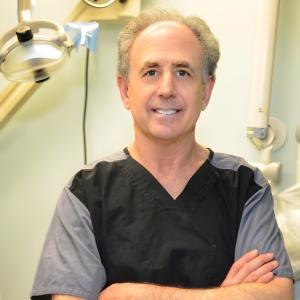Periodontist Researcher Shows Bioactive Dental Bone Grafts Help Save Teeth
New techniques and materials help prevent additional tooth loss after extraction
“Tooth extraction is one of the most common surgical procedures performed in dentistry today,” says Dr. Horowitz. “While the immediate focus of post-extraction is on healing of the extraction site itself, the impact of an extraction on adjacent teeth is a significant concern. The loss of a tooth can create a cascade of biomechanical, physiological, and pathological changes that can compromise the integrity and survival of neighboring teeth.”
One cause of damage to adjacent teeth is bone loss, which is common after tooth extraction. This weakens the support for teeth adjacent to the site of the extraction. Bone loss also can expose the roots of the adjacent teeth and make them more susceptible to cavities. The adjacent teeth can shift, which affects the mechanics and forces of chewing and may cause cracks in the teeth. If a tooth is extracted because of advanced gum disease or extensive cavities, adjacent teeth may be susceptible to decay and bone loss because of the same inflammation, infection, and other factors that contributed to the failure of the first tooth.
“My colleague and I placed a bioactive dentin bone graft into site of the tooth extraction in combination with a bioactive, amnion-chorion membrane barrier,” explains Dr. Horowitz. “Our article in Compendium of Continuing Education in Dentistry describes how this combination of materials improves the prognosis for teeth that are adjacent to the extraction site. Bone grafting can reduce bone resorption, while optimal barrier membranes can help guide the regrowth of soft tissue around the extraction site, strengthening the bone supporting the adjacent teeth.” Horowitz and colleagues also describe in a 2024 Medical Research Archives article the positive changes in bone formation after inserting this type of next-generation dental bone graft.
“As a periodontist, I often need to preserve, augment, and regenerate the remaining bone to enable the placement of one or more dental implants while protecting surrounding teeth,” says Horowitz. “Dental implants help patients regain self-confidence because they support restorations, enabling people to be better able to chew, speak and smile. By using next-generation bone graft and barrier membrane materials that increase the body's healing potential, teeth next to the tooth that has to be extracted can be saved.” This will simplify and decrease cost for future treatments.
Horowitz expects dental caries and resultant tooth damage, extractions, and implants to become more common in the coming years as states and the Federal government remove legislation for water fluoridation, which helps protect teeth from decay.
Robert A. Horowitz, DDS
Robert A. Horowitz, DDS
+1 914-723-3366
email us here
Visit us on social media:
Facebook
LinkedIn
Other
Legal Disclaimer:
EIN Presswire provides this news content "as is" without warranty of any kind. We do not accept any responsibility or liability for the accuracy, content, images, videos, licenses, completeness, legality, or reliability of the information contained in this article. If you have any complaints or copyright issues related to this article, kindly contact the author above.
Automotive Battery Thermal Management System Market Projected to Garner Significant Revenues By 2032
Minnesota Home Searches Simplified with Houzeo’s Innovative Mobile App Feature
Disinflation Trends Emerge Across Sub‑Saharan Africa, Creating Strategic Openings for FX and Bond Markets
Kalendarium
Więcej ważnych informacji
 Jedynka Newserii
Jedynka Newserii

 Jedynka Newserii
Jedynka Newserii

Konsument

Jednorazowe opakowania z plastiku mają do 2030 roku zniknąć z lokali gastronomicznych. Przekonanie klientów do pojemników wielorazowych może być wyzwaniem
Unijne przepisy zobowiązują firmy z branży HoReCa do ograniczenia w perspektywie 2030 roku jednorazowych opakowań z tworzyw sztucznych i zastąpienia choć części z nich opakowaniami wielorazowymi. Choć wielu Europejczyków pozytywnie odnosi się do oferowania opakowań wielorazowych przez lokale gastronomiczne, zaangażowanie użytkowników w zwrot pojemników może się okazać wyzwaniem.
Handel
Zbliża się szczyt UE–Chiny. Głównym tematem spotkania będzie polityka handlowa, w tym cła

Unia Europejska i Chiny odpowiadają łącznie za niemal 30 proc. światowego handlu, ale Europa wciąż ma ogromny deficyt handlowy w wymianie z Państwem Środka. Ostatnio relacje między Pekinem a Brukselą były pełne napięć, choćby w kwestii europejskich ceł na elektryki, chińskich ograniczeń eksportu metali ziem rzadkich, czy braku równowagi w dostępie do rynków. Szczyt UE–Chiny odbędzie się ponad półtora roku po poprzednim.
Polityka
Dane statystyczne pomogą przyspieszyć rozwój turystyki. Posłużą również do promocji turystycznej Polski

Główny Urząd Statystyczny we współpracy z resortem turystyki buduje nowoczesny portal analityczny Turystyka+. To interaktywne narzędzie, które umożliwia śledzenie zmian i porównywanie danych. Celem projektu jest wsparcie rozwoju turystyki na wielu poziomach – nie tylko krajowym, ale również lokalnym i regionalnym. Ma on być pomocny zarówno w podejmowaniu decyzji politycznych dotyczących infrastruktury turystycznej, jak i dla przedsiębiorców, co ma się przełożyć na rozwój sektora i gospodarki.
Partner serwisu
Szkolenia

Akademia Newserii
Akademia Newserii to projekt, w ramach którego najlepsi polscy dziennikarze biznesowi, giełdowi oraz lifestylowi, a także szkoleniowcy z wieloletnim doświadczeniem dzielą się swoją wiedzą nt. pracy z mediami.










.gif)

 |
| |
| |
|